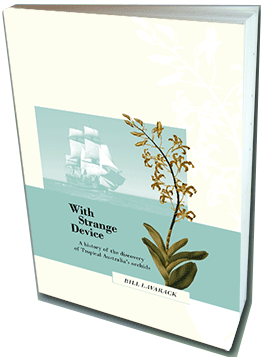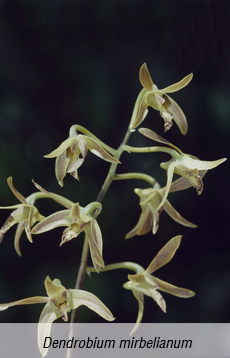The AOF has provided an interest free loan towards the production of this publication. On completion this publication will be available from the AOF.
<< BACK TO PROJECT LIST
Project: 291/2013
Title: Publication: ‘With Strange Device – A history of the discovery of Tropical Australia’s orchids’
Applicant: Dr. Peter S. Lavarack
Institution: Queensland
The family Orchidaceae is one of the most numerous in terms of species in the plant world. The majority are small and not particularly attractive, but a few are just the opposite. There are upwards of 260 species in the Australian Tropics, occupying a variety of ecological niches from mangroves and rainforests to savannah woodlands and heath on sandy flats. They grow as epiphytes or as terrestrials. Tropical Australia lies close to New Guinea and the Indonesian Islands which are both centres of distribution of orchids on a world scale.
Before James Cook’s expedition in the Endeavour, nothing was known of the orchids of the Australian tropics. The three species which Joseph Banks and Daniel Solander collected at the Endeavour River and a handful of others collected by Robert Brown on the Investigator remained the sum total of knowledge until settlements were established on the northern and eastern coasts in the 1860s. After that there was a rush of collectors who ranged from explorers to amateur naturalists to professional scientists collecting specimens and sending them to botanists based in the southern cities of Australia.
This book tells the stories of the collectors who often had to deal with attacks by the indigenous people who, naturally enough, resented the newcomers and with hardships such as lack of supplies and flooded creeks and rivers. Some expeditions ended in tragedy and there are many interesting tales of the troubles encountered. All the orchids of Tropical Australia are listed along with the first collector, the date and locality.
The title ‘With Strange Device’ refers to the unique floral structure of the orchids as described by Archibald Meston in a poem penned on Mt Bellenden Ker in 1893 about F.M. Bailey the Queensland Government Botanist:
The shades of night were falling fast,
As o’er the mountain summit passed
A botanist man, extremely nice,
Who bore a plant with strange device,
‘Dendrobium hispidum.’

Jack Wilkie who collected the type material of many new species in the 1940s, and 50s and Dendrobium mirbelianum which was originally named Dendrobium wilkianum by H.M.R. Rupp in 1941 and was first discovered in Australia by Jack Wilkie. The following is from the book:
John Henry Wilkie (1902 – 1997)
Jack Wilkie was born on the Croydon Goldfield in 1902. He lived most of his long life at Babinda. In his earlier days he prospected for gold in the Bellenden Ker Range, discovering the Bartle Frere Goldfield. These days in the rugged ranges made Wilkie into a resourceful bushman and also instilled in him a lifetime love of orchids. He sent specimens to Rev. Rupp, Trevor Hunt and Alick Dockrill. These specimens included 16 which were to become type specimens. Among these were: Dendrobium wilkianum, D. luteocilium, D. cancroides, Phaius pictus and Eria inornata. Jack Wilkie became the unofficial ‘king of Mt Bartle Frere’ climbing the 5000 foot mountain on numerous occasions and cutting the track for the installation of the Bellenden Ker cable car. His last climb of Bartle Frere was when he was 79. Three species were named in his honour, but none of these names survives today.


